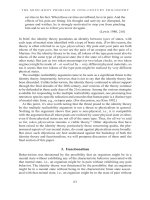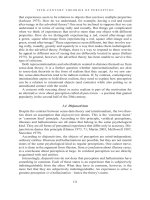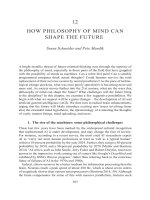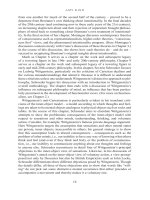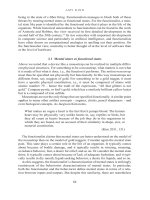Philosophy of mind in the twentieth and twenty first centuries the history of the philosophy of mind volume 6 ( PDFDrive ) (1) 286
Bạn đang xem bản rút gọn của tài liệu. Xem và tải ngay bản đầy đủ của tài liệu tại đây (101.98 KB, 1 trang )
T he boundaries of the mind
number of natural scientists),9 yet invest a lot of time in empirical studies of the
mind in the hope that they illuminate our philosophical theories.
Starting in the late 1950s and early 1960s, the 20th century witnessed the development of a robust and sophisticated defense of a naturalist conception of the
mind, and the emergence of cognitive science, an interdisciplinary approach to the
workings of the mind (see Chapter 11, the Rise of Cognitive Science). One prominent idea both in naturalist theories and in cognitive science is that the mind could
be understood on the analogy of computers (inspired by Turing’s groundbreaking work for example in Turing 1950).10 According to the classic functionalistcomputational picture of the mind, our core cognitive processes can be understood as programs that manipulate certain representations stored in the brain. The
central computing unit is connected to the periphery in two ways: our nervous
system transduces stimuli that arrive from the world to our sensory organs, and
also conveys certain tasks to be solved (for example by signaling that the body
needs nutrition). The information arriving to the central system is used to build an
inner representation of the world, which then helps the system to solve the tasks
posed for it (for example, by computing the navigations needed to reach food).
The solutions are then translated to action commands, which are communicated
to another component of the periphery, the motor system (the result being that the
organism moves towards the source of food).
One crucial point here is that in this so-called “sense-think-act cycle”, the central thinking module, which is sandwiched between the periphery of perception
and action, is conceived as running a highly abstract program; that is, a program
that can be realized by very different physical mechanisms, and would be, in
principle, compatible with a large variety of inputs and outputs, fashioned for all
sorts of sensory organs and all sorts of bodies to be moved. This idea actually has
very old roots: we saw a similar conception being present already in Aristotle and
Descartes, in the view that pure cognition is independent both of the body, and the
sensory-affective aspect of our mental life.
Descartes thought that everything material must work on mechanistic principles,
and he simply could not imagine how a programmed mechanism could account
for the creativity of human thought. Therefore, he held that the immaterial soul
must be the home for rational cognition. Descartes’ argument is based on some
empirical-scientific assumptions that are clearly superseded today. As we shall
see in section 3.4, the classic computationalist picture has come under increased
criticism. But even if the picture needs correction, we should not underestimate
the significance of having a conception of mental processes, the computationalfunctionalist conception, which makes sense – in a way that’s consistent with a
naturalist world-view – of something that completely baffled Descartes and others
for centuries (see Rey 1997, Chapter 2).
There are at least three boundary issues raised by naturalism and the functionalistcomputational theory of the mind. First, naturalist accounts of representations
usually rely on an external individuation of mental content. Second, functionalism
about the mind has the possible consequence that the physical basis of the mind
267

